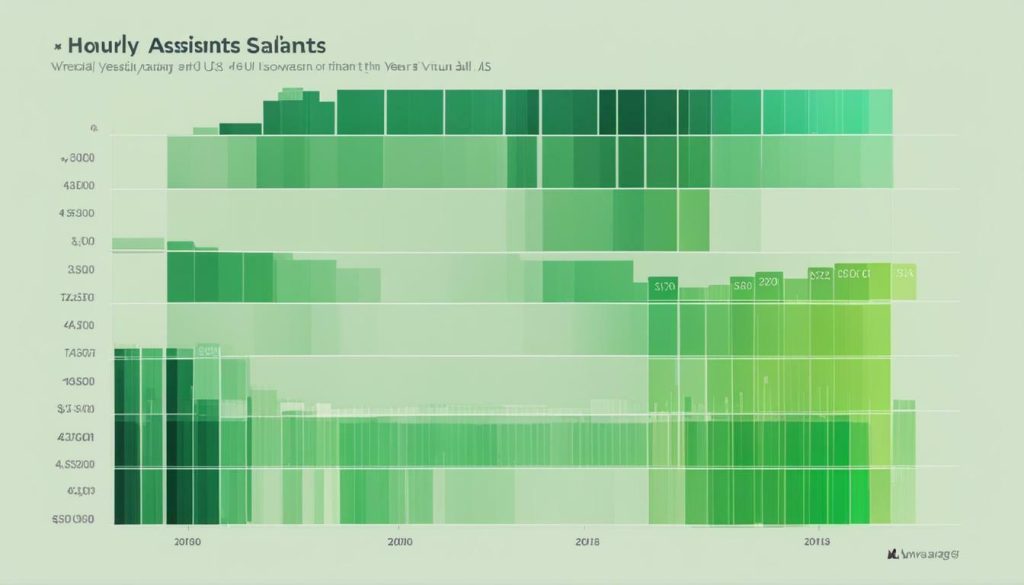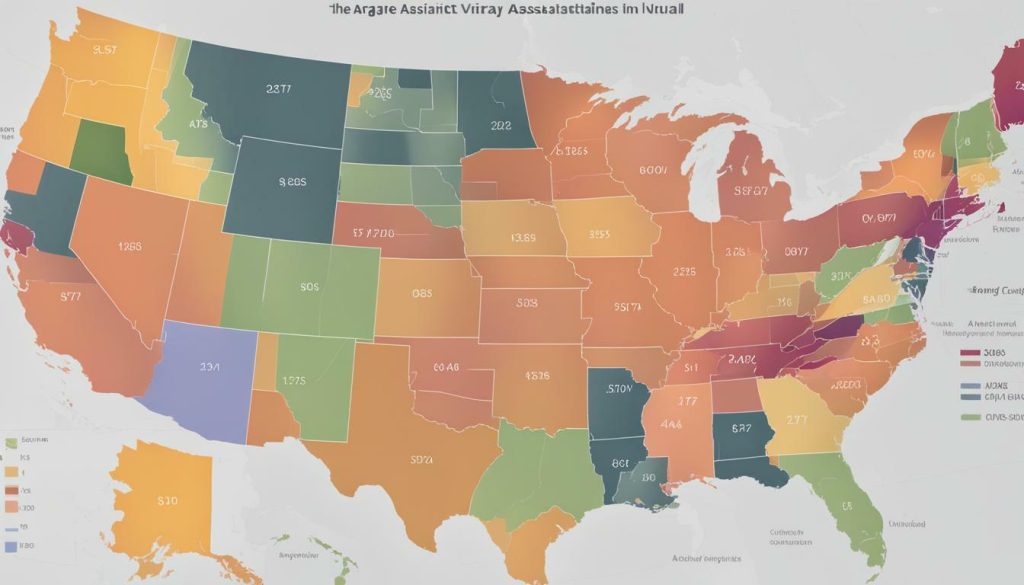
Are you curious about the average virtual assistant salary in the US? In this article, I will provide you with an overview of virtual assistant salaries in the country, exploring factors that influence pay, average salaries broken down by different timeframes, and insights from reputable sources like ZipRecruiter and Indeed. If you’re considering a career as a virtual assistant or simply want to stay informed about industry trends, keep reading for valuable insights.
- The average virtual assistant salary in the US varies depending on factors like experience, skillset, and location.
- According to ZipRecruiter, home-based virtual assistant positions have a wide salary range, with hourly rates ranging from $7.21 to $62.74.
- Weekly earnings can range from $288 to $2,510, while monthly earnings can range from $1,250 to $10,875.
- Annual salaries for virtual assistants can vary from $15,000 to $130,500.
- Indeed reports that virtual assistant salaries in the US range from $8 to $60 per hour, with an average of $19.80 per hour.
- Salaries also vary by state, with New York having an average salary of $49,348 and Alaska having the lowest average salary at $26,000.
- Factors influencing virtual assistant income include skill level, expertise, and years of experience.
- Skilled and experienced virtual assistants tend to earn higher wages.
- The demand for virtual assistants is growing, and they can save businesses up to 78% in operating costs.
Factors Influencing Virtual Assistant Salaries
Virtual assistant salaries can vary depending on several key factors. These factors include the virtual assistant’s experience, skillset, and location. Having a diverse range of skills and experience can significantly impact a virtual assistant’s earning potential. Those with specialized skills, such as social media management, graphic design, or content writing, may command higher salaries due to the increased demand for these services.
Location is another crucial factor that affects virtual assistant salaries. Cost of living and competition within the area play a significant role in determining compensation. Virtual assistants based in major metropolitan areas, where the cost of living is higher, generally earn higher wages compared to those located in smaller towns or rural areas. This is because the demand for virtual assistants is typically higher in urban areas, where businesses are more likely to require their services.
Additionally, factors like the virtual assistant’s level of expertise and years of experience contribute to salary fluctuations. As with any profession, individuals with extensive experience and a proven track record in delivering high-quality work are likely to command higher wages. Clients are willing to pay a premium for experienced virtual assistants who can provide exceptional service and deliver results.
Factors Influencing Virtual Assistant Salaries:
- Experience
- Skillset
- Location
- Expertise
- Years of experience

| Timeframe | Hourly Rate | Weekly Earnings | Monthly Earnings | Annual Salary |
|---|---|---|---|---|
| Minimum | $7.21 | $288 | $1,250 | $15,000 |
| Maximum | $62.74 | $2,510 | $10,875 | $130,500 |
According to ZipRecruiter, the salary ranges for home-based virtual assistant positions are quite extensive. Hourly rates range from $7.21 to $62.74, weekly earnings range from $288 to $2,510, monthly earnings range from $1,250 to $10,875, and annual salary ranges from $15,000 to $130,500.
Indeed reports that virtual assistant salaries in the US range from $8 to $60 per hour, with an average of $19.80 per hour. It is important to note that these figures may vary depending on the factors discussed earlier. Skill level, expertise, and years of experience will ultimately determine where a virtual assistant falls within the salary range.
Lastly, a breakdown of virtual assistant salaries by state reveals further variance in compensation. For example, New York has an average salary of $49,348, while Alaska has the lowest average salary at $26,000. These disparities can be attributed to the cost of living, regional economies, and market demand for virtual assistants within each state.
Factors Impacting Virtual Assistant Income:
- Skill level
- Expertise
- Years of experience
The growing demand for virtual assistants is driven by the cost-saving benefits they provide to businesses. According to a study, businesses can save up to 78% in operating costs by hiring virtual assistants instead of in-house employees. This cost difference is due to factors such as reduced overhead expenses, lower healthcare and benefits costs, and flexibility in contract arrangements.
In summary, virtual assistant salaries in the US can range widely and are influenced by various factors such as experience, skillset, location, expertise, and years of experience. The demand for virtual assistants is on the rise, and as businesses realize the cost-saving benefits, virtual assistants are becoming an integral part of the workforce.
Average Virtual Assistant Salaries: By the Hour, Week, Month, and Year
Let’s take a closer look at the average virtual assistant salaries based on various timeframes. When considering virtual assistant compensation, it’s important to understand the different ways in which these professionals are paid. Some virtual assistants charge an hourly rate, while others prefer to work on a project basis or a retainer agreement. Virtual assistant salaries can also be broken down into weekly, monthly, and annual estimates.
Hourly Rates:
According to data from ZipRecruiter, hourly rates for virtual assistants in the US can range from as low as $7.21 to as high as $62.74. These rates are influenced by factors such as experience, skillset, and geographical location. Skilled virtual assistants with specialized expertise tend to command higher hourly rates, while those with less experience may start at the lower end of the spectrum.
Weekly Earnings:
When looking at virtual assistant income on a weekly basis, ZipRecruiter reports that earnings can range from $288 to $2,510. The specific amount depends on factors such as the number of hours worked and the virtual assistant’s rate. For instance, a virtual assistant who charges $20 per hour and works 15 hours a week would earn $300.
Monthly Earnings:
Virtual assistants who prefer to work on a monthly basis can expect to earn a range of $1,250 to $10,875. This range demonstrates the flexibility and potential for higher income that virtual assistants can achieve. Virtual assistants with a solid client base and steady workload have the opportunity to earn a substantial monthly income.
Annual Salary:
Virtual assistant salaries on an annual basis can vary significantly based on factors like experience, skill level, and industry demand. ZipRecruiter states that annual incomes for virtual assistants can range from $15,000 to $130,500. This wide range showcases the earning potential that virtual assistants have and the impact that their expertise and experience can have on their overall compensation.
As you can see, virtual assistant salaries in the US can vary greatly depending on the timeframe and factors at play. From hourly rates to monthly incomes, virtual assistants have the opportunity to earn a competitive salary while providing valuable support to businesses and professionals across different industries.

According to ZipRecruiter, virtual assistant salaries can vary widely based on different factors. The salary ranges for home-based virtual assistant positions are as follows:
| Timeframe | Salary Range |
|---|---|
| Hourly Rate | $7.21 – $62.74 |
| Weekly Earnings | $288 – $2,510 |
| Monthly Earnings | $1,250 – $10,875 |
| Annual Salary | $15,000 – $130,500 |
These salary ranges reflect the diversity in compensation for virtual assistants in the US. Whether paid by the hour, week, month, or year, virtual assistant earnings can fluctuate significantly.
It’s important to note that while the lower end of the salary range may seem relatively low, many entry-level virtual assistants start at this level and can gradually increase their earnings as they gain experience and develop their skills. On the other hand, virtual assistants with more experience, specialized knowledge, and a proven track record often command higher salaries within the upper end of the range.
This data from ZipRecruiter provides valuable insights into the compensation landscape for virtual assistants, offering a glimpse into the earning potential and various pay structures available in this industry.

– Virtual assistant salaries can vary widely based on factors such as experience, skillset, and location.
– ZipRecruiter’s data reveals the salary ranges for home-based virtual assistant positions, including hourly rates, weekly earnings, monthly earnings, and annual salaries.
– Entry-level virtual assistants often start at the lower end of the salary range, while experienced professionals can earn higher wages within the upper end.
– The provided table visualizes the diversity of virtual assistant salaries across different timeframes.
– This information sheds light on the earning potential and pay structures available for virtual assistants in the US.
Indeed’s Data on Virtual Assistant Salaries in the US
According to Indeed, virtual assistant salaries in the US can range from a minimum to a maximum hourly rate. The average virtual assistant hourly rate in the US is $19.80. However, this can vary depending on several factors such as experience, skillset, and location.
Virtual assistants with more experience and a specialized skillset tend to command higher wages. Depending on their expertise and years of experience, virtual assistants can earn anywhere from $8 to $60 per hour. This wide range allows for flexibility in compensation, making it possible for virtual assistants to negotiate rates based on their qualifications.
To further explore the range of virtual assistant salaries, let’s take a look at the average salaries in different states across the US. New York leads the pack with an average salary of $49,348, while Alaska has the lowest average salary at $26,000. These variations showcase how geographical location can impact virtual assistant earnings.
| State | Average Salary |
|---|---|
| New York | $49,348 |
| California | $45,826 |
| Massachusetts | $39,998 |
| Texas | $36,480 |
| Florida | $34,924 |
| Alaska | $26,000 |
As businesses increasingly rely on virtual assistants to streamline operations and reduce costs, the demand for these professionals continues to grow. Virtual assistants can help businesses save up to 78% in operating costs, making them an invaluable asset. With such demand and cost-saving benefits, virtual assistant salaries are expected to remain competitive and present lucrative opportunities for skilled professionals in the US.

- Virtual assistant salaries in the US can range from a minimum to a maximum hourly rate, with an average of $19.80 per hour.
- Factors such as experience, skillset, and location influence virtual assistant salaries.
- The average virtual assistant salary varies by state, with New York leading at $49,348 and Alaska having the lowest average at $26,000.
- The demand for virtual assistants is increasing, and they can save businesses up to 78% in operating costs.
| Timeframe | Hourly Rate | Weekly Earnings | Monthly Earnings | Annual Salary |
|---|---|---|---|---|
| Minimum | $8 | $288 | $1,250 | $15,000 |
| Maximum | $60 | $2,510 | $10,875 | $130,500 |
Virtual Assistant Salaries by State
Virtual assistant salaries can differ significantly from one state to another. Factors such as cost of living, business demand, and local job markets can all impact the average pay for virtual assistants in different locations across the United States. Let’s take a closer look at the average virtual assistant salaries in various states:
| State | Average Virtual Assistant Salary |
|---|---|
| California | $45,120 |
| Florida | $40,450 |
| Texas | $37,890 |
| New York | $49,348 |
| Alaska | $26,000 |
These figures are based on average annual salaries and provide a general idea of the virtual assistant pay scale in different states. It’s important to note that these numbers are subject to change and can vary based on individual circumstances.
When considering a career as a virtual assistant, it is essential to research and understand the local job market and compensation trends within your state. Factors such as demand for virtual assistants, competition, and cost of living will all come into play when negotiating your salary or rates for services.
“As a virtual assistant, my income is directly affected by the state I work in. Understanding the average salaries in my area helps me set realistic expectations and ensure fair compensation for my skills and expertise.” – Emily, experienced virtual assistant.
Keep in mind that virtual assistant salaries are not solely determined by location. Other factors, including years of experience, specialized skill sets, and the complexity of tasks, will also influence earning potential. Virtual assistants with a high level of expertise and a proven track record may be able to command higher wages regardless of their geographical location.

Overall, virtual assistant salaries can vary significantly depending on the state in which you work. It is important to stay informed about the average compensation in your area and leverage your skills and experience to negotiate fair pay.
Factors Impacting Virtual Assistant Income
The income of virtual assistants can be affected by various factors, including their level of skill and experience. As virtual assistants gain more experience and develop a specialized skill set, they often have the opportunity to command higher pay rates. Clients are willing to pay a premium for virtual assistants who can demonstrate expertise in areas such as social media management, content creation, project management, or customer service.
“Having a diverse range of skills and the ability to handle multiple tasks efficiently has allowed me to negotiate higher rates with my clients,” says Jane Roberts, a seasoned virtual assistant with over five years of experience.
“I’ve invested time and effort in honing my skills and staying updated with the latest industry trends. This has not only increased my earning potential but also allowed me to attract higher-paying clients who value my expertise.”
In addition to experience and skill level, the virtual assistant’s location can also impact their income. Virtual assistants based in metropolitan areas or cities with a higher cost of living often have the opportunity to earn higher wages compared to those based in rural or less expensive areas. However, the rise of remote work has made it possible for virtual assistants to work with clients from all over the world, leveling the playing field for income potential.
Overall, virtual assistant income can vary significantly depending on several factors. While skill level, experience, and geographical location play a significant role, it’s important for virtual assistants to continuously invest in their professional development and stay up-to-date with industry trends to maximize their earning potential.

The Growing Demand for Virtual Assistants and Cost Savings
The demand for virtual assistants is on the rise, and they offer considerable cost savings for businesses. As companies strive to streamline their operations and increase efficiency, virtual assistants have become an invaluable resource. By outsourcing tasks to virtual assistants, businesses can save both time and money.
Virtual assistants are skilled professionals who can handle a wide range of administrative, creative, and technical tasks remotely. They can manage calendars, schedule appointments, handle customer inquiries, create content, manage social media accounts, and even provide bookkeeping and accounting services. With their diverse skill sets, virtual assistants can take on tasks that would otherwise require hiring multiple specialized employees.
One of the key advantages of hiring virtual assistants is the savings in operational costs. Virtual assistants typically work on a freelance basis, which means businesses do not have to bear the additional expenses associated with hiring full-time employees, such as benefits, office space, equipment, and taxes. According to studies, businesses can save up to 78% in operating costs by utilizing virtual assistants.
Furthermore, virtual assistants offer flexibility and scalability. Businesses can easily adjust the workload of a virtual assistant based on their needs, without the hassle of hiring or terminating employees. This level of flexibility allows companies to adapt quickly to changing demands and focus on their core operations.
FAQ
What is the average virtual assistant salary in the US?
The average virtual assistant salary in the US varies depending on factors such as experience, skillset, and location.
How much do home-based virtual assistants earn on an hourly basis?
Home-based virtual assistants can earn hourly rates ranging from $7.21 to $62.74.
What are the weekly earnings for virtual assistants?
Virtual assistants’ weekly earnings can range from $288 to $2,510.
How much do virtual assistants earn on a monthly basis?
Monthly earnings for virtual assistants can range from $1,250 to $10,875.
What is the annual salary range for virtual assistants?
Virtual assistants can earn annual salaries ranging from $15,000 to $130,500.
What is the average hourly rate for virtual assistants in the US?
According to Indeed, the average hourly rate for virtual assistants in the US is $19.80.
Which state has the highest average virtual assistant salary?
New York has the highest average virtual assistant salary at $49,348.
Which state has the lowest average virtual assistant salary?
Alaska has the lowest average virtual assistant salary at $26,000.
What factors influence virtual assistants’ income?
Factors that influence virtual assistants’ income include skill level, expertise, and years of experience.
How much can businesses save by hiring virtual assistants?
Businesses can save up to 78% in operating costs by hiring virtual assistants.



